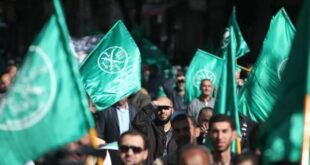When trying to understand the root causes of the violence towards Israel and increasing instability across the Middle East, the Iranian regime’s hateful worldview and destructive behavior are the epicenters of it all.
Israel’s September 27 assassination of Hezbollah Secretary General Hassan Nasrallah marks a new era in the conflict between Israel and the Islamic Republic of Iran and its terror proxies in Lebanon and beyond. In the week leading up to the Israeli hit on Hezbollah’s Beirut headquarters, the Israeli forces struck over 1,600 targets in Lebanon. The key to understanding these developments is the Iranian regime’s Hezbollah-Hamas nexus, as demonstrated by Hezbollah’s active and self-declared support to Hamas’ war on Israel since October 7.
Following Hamas’ October 7 attack, Hezbollah joined the Iranian regime’s other terrorist proxies in the Middle East, including those in Bahrain, Iraq, and Yemen, to target Israel with a range of ever-escalating drone and missile attacks.
This is not unexpected since Hezbollah’s raison d’être is the destruction of Israel. In its 1985 “Open Letter to the Oppressed of the World,” Hezbollah states that its “struggle against the rapist Israel emanates from a doctrinal-historical understanding.” They also reject “all attempts at mediation between [Hezbollah] and Israel” and even “consider the mediating parties as aggressors,” stating, “Our confrontation with [Israel] will only cease when it is completely obliterated from the face of the earth.”
Hezbollah’s actions have been restrained by Israeli and U.S. deterrence, leading to a senior Hamas official stating that although Hamas appreciates Hezbollah attacks targeting Israel, they “need more” from the group. Nevertheless, the terror nexus between Hamas and Hezbollah, central to the Iranian regime’s designs for the region, is evident in the incendiary statements made by senior Hezbollah leadership and the accompanying campaign of some 8,000 rocket attacks from Lebanon.
On November 3, 2023, less than one month after the October 7 attack, Hezbollah Secretary General Nasrallah gave his first post-October 7 public address, where he praised the mass murder and kidnapping of Israeli citizens. He called the massacre “the great, grand, jihadist operation [of] October 7,” adding, “this great, blessed, and widespread operation … was a heroic, courageous, innovative, well-executed, grand, great work deserving all praise.”
Nasrallah went on to praise the Islamic Republic of Iran for its support of the so-called “Axis of Resistance”—the network of Iranian regime proxies, including Hezbollah, ranged against Israel and sworn to its destruction, saying “The Islamic Republic of Iran, since Imam Khomeini […] until today under the leadership of Imam Khamenei […] openly adopts, supports, and backs the resistance movements in Lebanon, Palestine, and the region.”
A few days later, on November 11, Nasrallah presented October 7 as the starting point of continuous attacks on Israel from the Islamic Republic’s proxies, saying, “We are in a battle of accumulating achievements and points, a battle of time.” Citing the displacement of Israeli civilians as a success of Hezbollah bombardment, he said, “[these] migrants within Israeli society […] create chaos. The economic losses, both direct and indirect, on this entity […] will eventually increase the pressure on the enemy and the time will become tighter.”
Since these speeches, Hezbollah has launched thousands of rockets into northern Israel, displacing tens of thousands of Israeli civilians from their homes. Hezbollah’s rocket and missile attacks have become a near-daily experience, which has resulted in multiple Israeli deaths and injuries, as well as severe damage to several cities, villages, and towns in Israel’s north.
One of the deadliest attacks by Hezbollah took place on July 27, 2024, when a rocket fired by the terrorist group landed on a soccer field in the Israeli-Druze town of Majdal Shams, killing twelve children.
Three days later, Fuad Shukr, a senior Hezbollah figure, was killed in an Israeli airstrike on the Haret Hreik suburb of Beirut. The following day, Ismail Haniyeh, head of Hamas’ political bureau, was also killed while visiting Tehran to attend the swearing-in of Iranian President Masoud Pezeshkian.
In response, Hezbollah raised its rhetoric in coordination with the Iranian regime and fellow regional proxies, swearing an unprecedented retaliation against Israel for these two assassinations, saying, “This is an open battle on all fronts and has entered a new phase,” adding, “they [i.e., Israel] do not know now from where the response will come—from the north of Palestine, from the east of Palestine, from the south of Palestine. Will this response come separately or simultaneously? Israel doesn’t know where it’s heading.”
In the days that followed, Hamas paid tribute to Hezbollah in letters affirming the group’s “solidarity and unity” with Hezbollah and calling for reopening “the gates of Khaybar,” a reference to the massacre and expulsion of Jews from the Arabian Peninsula in the seventh century AD.
This threat culminated in an August 25 preemptive strike by Israel against Hezbollah targets in southern Lebanon in response to what they described as “imminent threats” to Israeli civilians. The operation targeted multiple sites, including weapons depots, rocket launchers, and buildings used by Hezbollah operatives. Notably, many of these weapons were stored within residential areas in Lebanon’s Bekaa Valley, further demonstrating that like Hamas, Hezbollah stores and fires rockets from amongst civilian populations.
Nasrallah repeatedly stated that he sees Hezbollah’s role as helping Hamas as a fellow member of the “Axis of Resistance,” and thwarting Israel’s attempts to free Israeli hostages and secure Israel’s borders by drawing on its previous experience in the 2006 Lebanon war. The nearly two-month conflict erupted on July 12, 2006, when Hezbollah launched a cross-border attack, killing, wounding, and kidnapping Israeli soldiers.
In his speech on November 3, 2023, for example, Nasrallah said, “Well, what happened in Lebanon in 2006? […] After the operation to capture the two soldiers, they set the goal of the war to eliminate Hezbollah, crush Hezbollah. […] But in the end, […] the enemy was forced to stop and back down from its goals.”
This echoes the response of Iranian Supreme Leader Ali Khamenei to the 2006 Lebanon war and the Hezbollah-initiated hostilities that sparked it. Days after the ceasefire in 2006, Khamenei praised Hezbollah and its Secretary General Nasrallah for the destructive war they started, saying, “You have imposed your military superiority on the Zionist entity and […] ridiculed the myth that the Zionist army is invincible.”
As these statements demonstrate, Hezbollah’s hostility towards Israel must be seen not only in the light of months of escalating attacks and rhetoric but also in decades of being the primary conduit for the Islamist Republic of Iran’s attacks on the Jewish state.
When trying to understand the root causes of the violence towards Israel and increasing instability across the Middle East, the Iranian regime’s hateful worldview and destructive behavior are the epicenters of it all. Nasrallah’s incendiary remarks in the months leading to his death made that clear yet again.
 Geostrategic Media Political Commentary, Analysis, Security, Defense
Geostrategic Media Political Commentary, Analysis, Security, Defense





